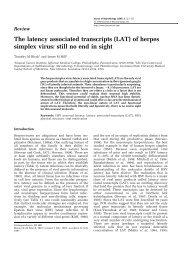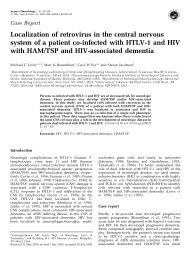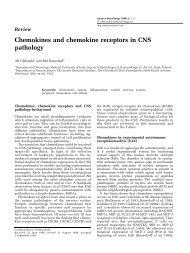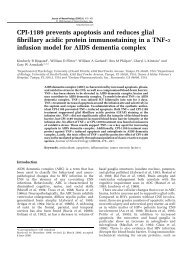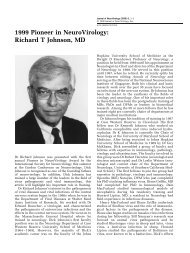PDF (213 KB) - Informa Healthcare
PDF (213 KB) - Informa Healthcare
PDF (213 KB) - Informa Healthcare
Create successful ePaper yourself
Turn your PDF publications into a flip-book with our unique Google optimized e-Paper software.
JC virus T ′ protein function<br />
16 RJ Frisque et al<br />
already available for JCV TAg. Numerous functional<br />
domains influencing viral DNA replication and oncogenic<br />
behavior are localized within the region of overlap<br />
between TAg and the T ′ proteins. Using a sitedirected<br />
mutagenesis approach, the shared donor or<br />
the three unique acceptor T ′ splice sites were altered<br />
to eliminate expression of one, two, or all three T ′ proteins.<br />
These mutant genomes were transfected into<br />
permissive human fetal glial cells, and it was demonstrated<br />
that the loss of all three T ′ proteins resulted in<br />
a 10- to 20-fold reduction in DNA replication activity<br />
(Trowbridge and Frisque, 1995; Prins and Frisque,<br />
2001). It was also determined that mutation of the<br />
T ′ 135 acceptor splice site led to the use of cryptic sites<br />
resulting in the appearance of new T ′ species.<br />
To assess the transforming potential of the T ′ proteins,<br />
initial work examined their ability to interact<br />
with the tumor suppressor protein, pRB, and its related<br />
family members, p107 and p130. TAg, T ′ 135 ,<br />
T ′ 136 , and T′ 165 , purified from insect cells infected with<br />
recombinant baculoviruses, were mixed with extracts<br />
of human MOLT-4 cells containing pRB-related proteins.<br />
Each viral protein was found to interact with<br />
the hypophosphorylated forms of pRB, p107, and<br />
p130 in this in vitro assay (Bollag et al, 2000). Importantly,<br />
the JCV proteins exhibited differential binding<br />
to the pRB family members. Recent models suggest<br />
that in addition to binding pRB family members<br />
through their LXCXE domain, polyomavirus tumor<br />
proteins must effect the release of E2F transcription<br />
factors found in complex with these family members<br />
(Sheng et al, 1997; Sullivan et al, 2000, 2001).<br />
The viral proteins, via their J domain, interact with<br />
Hsc70, a molecular chaperone protein, to effect this<br />
release. Using extracts of POJ cells expressing all<br />
five JCV early proteins and an immunoprecipitationimmunoblotting<br />
assay, at least one of the JCV proteins<br />
was shown to bind Hsc70 in vivo. Recent experiments<br />
involving Rat 2 cell lines expressing individual JCV<br />
early proteins (see below) revealed that T ′ 135 interacts<br />
with Hsc70. This result is in contrast to that reported<br />
for an N-terminal truncated form of SV40 TAg, called<br />
N136, that fails to form a stable complex with the<br />
molecular chaperone (Sullivan et al, 2001).<br />
Functional analyses of T ′ proteins expressed<br />
in G418-selected cells<br />
the<br />
To investigate T ′ protein function further, we have<br />
used a G418 selection protocol to create rat and<br />
mouse cell lines expressing one or more JCV early<br />
proteins (Kilpatrick, Bollag, McElrath, and Frisque,<br />
manuscript in preparation). During the initial isolation<br />
of these lines, an observation was made that may<br />
be relevant to the question of viral protein function.<br />
Rat 2 fibroblasts were transfected with constructs<br />
containing either the intact JCV early coding region<br />
or individual TAg, T ′ 135 ,T′ 136 or T′ 165 cDNAs under<br />
control of the cytomegalovirus (CMV) promoter.<br />
Cell lines expressing all five JCV proteins or each T ′<br />
protein independently were readily established by<br />
single-cell cloning following G418 selection. In lines<br />
established with the TAg cDNA plasmid, both TAg<br />
and the T ′ proteins were produced, presumably because<br />
the TAg cDNA retains the T ′ splice sites. To<br />
eliminate expression of T ′ mRNAs and proteins by<br />
the TAg cDNA, the T ′ donor splice site was mutated,<br />
and the altered construct was transfected into Rat 2<br />
cells. Upon G418 selection, only a single line expressing<br />
TAg in the absence of the other early proteins<br />
could be isolated. TAg was expressed at relatively low<br />
levels in these cells, and sequence analysis indicated<br />
that the integrated TAg gene encoded a wild-type protein.<br />
Preliminary experiments utilizing mouse NIH-<br />
3T3 cells have yielded similar results. One interpretation<br />
of these data is that TAg induces apoptosis in<br />
the rodent cells, and that T ′ proteins and/or small t<br />
protein (tAg) block this activity. It should be noted<br />
that SV40 TAg and tAg may have proapoptotic or<br />
antiapoptotic activities depending upon experimental<br />
conditions (Gjoerup et al, 2001 and references<br />
therein).<br />
The G418-selected lines expressing different JCV<br />
proteins have been assessed for cell-doubling time<br />
and for saturation density in medium supplemented<br />
with 1% or 10% fetal bovine serum (Kilpatrick et al,<br />
manuscript in preparation). Growth parameters of<br />
cloned, independent lines expressing all five early<br />
proteins together or TAg and T ′ proteins individually<br />
were compared to the parental Rat 2 line and to a JCVtransformed<br />
line isolated from a dense focus assay.<br />
Two G418-selected lines expressing the intact JCV<br />
early region exhibited accelerated growth rates and<br />
elevated saturation densities, although these transformation<br />
phenotypes did not attain the levels exhibited<br />
by the control transformed line. Cells producing<br />
a single viral protein (either TAg, T ′ 135 ,T′ 136 ,orT′ 165 )<br />
displayed growth parameters only slightly elevated<br />
above those of the Rat 2 parental line; by these criteria<br />
they did not appear to be transformed. Earlier<br />
studies indicated that most G418-selected cells expressing<br />
JCV early proteins fail to exhibit an aggressive<br />
transformed phenotype, presumably because expression<br />
levels of the tumor proteins fail to attain a<br />
required threshold necessary for complete transformation<br />
(Trowbridge and Frisque, 1993). It might be<br />
important to analyze a larger number of independent<br />
cell lines and assess a wider range of growth parameters<br />
to understand the contribution of T ′ proteins to<br />
the transformation process.<br />
Availability of the G418-selected Rat 2 lines has<br />
permitted us to examine in vivo interactions between<br />
individual JCV early proteins and the pRB family<br />
of proteins (Kilpatrick et al, manuscript in preparation).<br />
Lysates of these cells were immunoprecipitated<br />
with antibodies specific either for pRB, p107, and<br />
p130 or for JCV early proteins. Complexes were electrophoresed<br />
on polyacrylamide gels and subjected to



